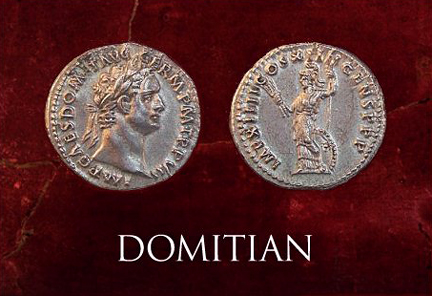

Obv. IMP CAES DOMIT AVG GERM P M TR P VII. Laureate head right; Rev. IMP XIIII COS XIIII CENS PPP. Minerva standing left, holding thunderbolt and spear, shield at feet. The legend on the obverse abbreviates Imperator. Caesar. Domitian. Augustus. Germanicus. Pontifex Maximus. Tribunicia. Potestas. VII; the reverse reads Imperator XIIII. Consul XIIII. Censor Perpetuus. Pater Patriae, which dates the coin to AD 88.
Insistent on his official honors, from his praenomen of imperator and dynastic title Caesar to that of Germanicus, which he assumed in AD 83, Domitian's tribunician power, acclamations as imperator, and number of consulships are fastidiously indicated, until there is virtually no room left on the coin to record them all. That same year, the coinage of Domitian also settles into one of four main reverse types, all in praise of Minerva, the goddess whom Domitian most revered.
In late AD 85, Domitian further assumed the office of censor in perpetuity, an unprecedented action that antcipated his later tyranny. Afterwards, it came to be accepted that the Censorship was part of the imperial office and no longer was indicated on coins.
The younger son of Vespasian, Domitian succeeded to the throne upon the premature death of his brother Titus in AD 81, the year after the great fire. Known for his building program, he restored the Temple of Jupiter Optimus Maximus, plating the doors with gold and gilding the bronze tiles of the roof, and completed work on the Arch of Titus, the Temple of Vespasian, and the Forum Transitorium. He also had much of the Palatine Hill leveled for the construction of the imperial palace.
Domitian had claimed for himself the title of "Germanicus" in AD 83 to recognize his victories in Germany. (That same year, Agricola defeated the Caledonian tribes at Mons Graupius but was recalled because the emperor had become jealous of his military success.) He elevated the silver content of the coinage to that of Augustus, only to devalue it again in AD 85, when it was realized that imperial revenue suffered as a result.
Domitian inaugurated the Ludi Capitolini (Capitoline Games) in AD 86 and also celebrated the Ludi Saeculares (Secular Games) in AD 88, which last had been celebrated by Augustus a century before (traditionally calculated to be 110 years). That year, too, a legion on the Rhine rebelled and, although the insurrection quickly was suppressed, it marked a recognized shift in Domitian's reign. Already suspicious, he became more ruthless and increasingly at odds with the Senate. There were conspiracies and scandal, as well, when Domitian, who had made himself censor for life with responsibility for public conduct and morals, had an open affair with his niece Julia, who later died of an abortion. In AD 96, Domitian was assassinated as part of a palace conspiracy involving his own wife. Declared Damnatio memoriae by the Senate, Suetonius relates that it bitterly decreed that "all inscriptions referring to him must be effaced, and all records of his reign obliterated."
In a bizarre footnote, Procopius conveys a story in his Anecdota or "Secret History" (c. AD 550) that presumably was invented to explain the appearance of a smashed statue of Domitian that had been pieced back together again.
"...the Senate passed a decree that not even the name of this emperor should remain in inscriptions, nor any statue or portrait of him be preserved. Cerainly from the inscriptions everywhere in Rome, and wherever else his name had been inscribed, it was chiselled out, as can still be seen, leaving all the rest intact; and nowhere in the Roman Empire is there a single likeness of him except for a solitary bronze statue, which survived in the following way.
Domitian's consort was a woman of good birth, and highly respected, who had herself never done the least wrong to any man alive, or approved a single one of her husband's actions. So she was very highly esteemed, and the Senate at this time sent for her and invited her to ask for anything she liked. She made only one request—that she might take Domitian's body and bury it, and set up a bronze statue of him in a place of her own choosing. The Senate agreed to this; and the widow, wishing to leave to later generations a monument to the inhumanity of those who had carved up her husband, devised the following plan. Having collected Domitian's flesh, she put the pieces together carefully and fitted them to each other; then she stitched the whole body together and showed it to the sculptors, asking them to make a bronze statue portraying the tragic end of the dead man. The artists produced the statue without loss of time; and the widow took it and erected it in the street that leads up to the Capitol, on the right-hand side as you go there from the Forum: it showed the appearance and the tragic end of Domitian, and does so to this day."
References: Roman Historical Coins (1990) by Clive Foss; Roman Imperial Coinage: Vol II (1926) by Harold Mattingly and Edward A. Sydenham; Coins of the Roman Empire in the British Museum: Vol II (1930) by Harold Mattingly; The Emperor Domitian (1992) by Brian W. Jones; Tom Cederlind Catalog 125 (2002).
Suetonius: The Twelve Caesars (1979) translated by Robert Graves and revised by Michael Grant (Penguin Books); Procopius: The Secret History (1966) translaed by G. A. Williamson (Penguin Classics).